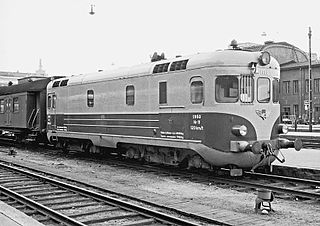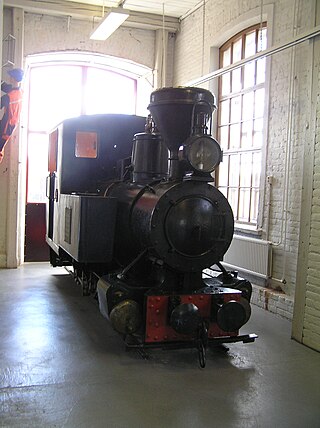
VR-Group Plc, commonly known as VR, is a government-owned railway company in Finland. VR's most important function is the operation of Finland's passenger rail services with 250 long-distance and 800 commuter rail services every day. With 7,500 employees and net sales of €1,251 million in 2017, VR is one of the most significant operators in the Finnish public transport market area.

A 4-6-0 steam locomotive, under the Whyte notation for the classification of steam locomotives by wheel arrangement, has four leading wheels on two axles in a leading bogie and six powered and coupled driving wheels on three axles with the absence of trailing wheels.

Under the Whyte notation for the classification of steam locomotives, 0-10-0 represents the wheel arrangement of no leading wheels, ten powered and coupled driving wheels on five axles and no trailing wheels. In the United Kingdom, this type is known as a Decapod, a name which is applied to 2-10-0 types in the United States. In the United States, the type is known as ten-coupled.

Neilson and Company was a locomotive manufacturer in Glasgow, Scotland.

The Sm3 Pendolino is a class of high-speed body-tilting trains operated by VR Group. It is a member of the Pendolino train family; its design is based on the ETR 460. The first two trainsets were assembled in Finland by Rautaruukki-Transtech in the mid-1990s. The rest of the series of eighteen EMUs were built by Fiat Ferroviaria between 2000 and 2006. The trains serve most of Finland's major cities such as Helsinki, Turku, Oulu and Joensuu with a maximum speed of 220 km/h (140 mph), although this speed is only attained between Kerava and Lahti. The train has a power output of 4,000 kW (5,400 hp) and weighs 328 tonnes.

The VR Class Hr11 was the first class of line-haul diesel locomotives used by Valtionrautatiet. Only five units were built, all delivered by Valmet in 1955. The Maybach diesel engines used in the locomotives proved highly unreliable, resulting in a complete overhaul of the engine-transmission system in 1956–58, but this did not solve all of the reliability problems. The Hr11 series was withdrawn from service in 1972.

The Finnish Steam Locomotive Class B1 is an 0-4-2ST built by Beyer, Peacock & Company, at its Gorton Foundry in Manchester, England. Nine were constructed between 1868 and 1890. They were designed for use as shunting locomotives.

Before 1942, the VR Class Vr1 were originally classified as L1. The Vr1 was a powerful and effective locomotive. Part of them were built by Tampella and part by Hannoversche Maschinenbau AG of Germany. They were numbered 530–544, 656–670, 787–799 and were nicknamed “Kana” ("Hen"). They were operation from 1913-1974.

The VR Class Vr3 was a class of steam locomotive built in Finland. Before 1942, the class was known as O1. They were nicknamed Kukko and they have the same frames and boiler as the Vr Class Pr1 (Paikku) locomotive. The first locomotive was ordered in 1924 from Hanomag of Germany, number 10 351 and it was numbered 752. The remaining 4 were produced by Tampella Oy in Tampere. They were numbered 752 to 756.

The VR Class Tr1 is a class of heavy freight locomotive built in Finland and Germany. Before 1942 VR Class Tr1s originally had the class name R1. They were nicknamed “Risto”, after the Finnish President Risto Ryti. They were numbered 1030–1096.

Russian steam locomotive U-127 is a 4-6-0 locomotive of type Russian locomotive class U, preserved at the Museum of the Moscow Railway next to Paveletsky Rail Terminal in Moscow. The locomotive was the first Russian steam locomotive preserved.

VR Class Tve2 was a VR Group diesel shunting locomotive. They were ordered from the Saalasti Oy engineering company and built between 1962 and 1964. Locomotives was sent to the Turenki sugar factory. A total of 8 units. The manufacturer's designation for the model was OTSO2 and OTSO2/VR.

The Finnish Steam Locomotive Class A5 was a class of two locomotives, being the first class of locomotive manufactured in Finland. These first Finnish locomotives were production experiments, which allowed the State Railways to investigate the construction methods of locomotives. The State Railways locomotives ordered the construction of a workshop in Helsinki in 1868, at the same time 10 passenger locomotives were ordered from Great Britain for the St. Petersburg railway line. As a result, the locomotives produced in the Helsinki workshop were similar to those produced in Great Britain.

The Finnish Steam Locomotive Class C5 were ordered in 1880 by the Finnish State Railways from the German Hanomag factory for the Tampere–Vaasa railway line. The locomotives were completed between 1881–1882 and received the Class designation C5. The C5 locomotives had inside cylinders, as in other C-series locomotives. Originally it was planned that the locomotives be used for both freight and passenger duties. But passenger locomotives were considered unnecessary, because at that time the maximum speed of trains on the Tampere and Vaasa railway line was only 26.7 kilometres per hour (16.6 mph). C5 locomotives soon proved to be insufficiently powerful for the gradients of the Tampere and Vaasa railway line. C5 locomotives were moved to the flatter Seinäjoki–Oulu line, where they performed satisfactorily.

Finnish Steam Locomotive Class F1 was a class of tank locomotives, which did not have to be turned at terminal stations. The water tank was located below the space behind the cab, in contrast to more modern tank locomotives where the water tanks usually placed either side of or on top of the boiler.

The VR Class Sk1, originally known as the Finnish Steam Locomotive Classes G1, G2 & G4, were a series of 60 2-6-0 locomotives built for the Finnish State Railways by Swiss Locomotive & Machine Works in 1885. Two are preserved, one at, at the Finnish Railway Museum, and the other at Hyvinkää.

The VR Class Vk3 was originally called the Finnish Steam Locomotive Class I3. The Finnish State Railways ordered three similar classes of locomotives; The American-built Baldwin Class I1s, and the Class I2s and Class I3s, built at Tampella. All were tank locomotives, which did not have to be turned at terminal stations and could run in both directions at the same speed.

The VR Class Sk3, originally known as the Finnish Steam Locomotive Classes G3, G5, G10 & G11, was a class of 88 2-6-0 steam locomotives, built for the Finnish State Railways from 1892 to 1903 at Tampella. One is preserved, at the Finnish Railway Museum

VR Class Rro was a locomotive of Finnish origin. The Rro portion of the name comes from a word RautatieRakennusOsasto which is the Railway Construction Department.





















